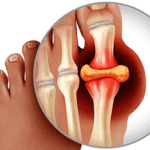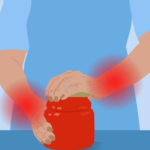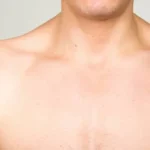Introduction
A dislocated shoulder is a painful injury that occurs when the upper arm bone (humerus) pops out of the shoulder socket (glenoid). The shoulder joint is particularly prone to dislocation due to its wide range of motion, making it one of the most frequently dislocated joints in the human body. Understanding the symptoms of a dislocated shoulder and knowing the appropriate actions to take can significantly impact recovery outcomes.
Anatomy of the Shoulder Joint
To understand the implications of a shoulder dislocation, it’s crucial to have a basic understanding of the shoulder’s anatomy. The shoulder is a ball-and-socket joint, comprising three main bones:
- Humerus: The upper arm bone.
- Scapula: The shoulder blade.
- Clavicle: The collarbone.
The shoulder joint is stabilized by a combination of muscles, tendons, and ligaments. This complex structure allows for a wide range of motion but also makes the shoulder susceptible to injuries like dislocation.
Common Symptoms of a Dislocated Shoulder
Dislocating your shoulder can cause immediate and intense symptoms. Here are the most common signs:
1. Severe Shoulder Pain
- Immediate Pain: The pain from a shoulder dislocation is typically intense and occurs immediately after the injury.
- Localized Pain: Pain is usually concentrated in the shoulder area but can also radiate down the arm.
2. Visible Deformity
- Out-of-Place Shoulder: The shoulder may look visibly deformed or out of place, often appearing square instead of rounded.
- Protruding Bone: In some cases, the upper arm bone may protrude under the skin.
3. Swelling and Bruising
- Rapid Swelling: The area around the shoulder may swell quickly after dislocation.
- Bruising: Bruising can develop, spreading down the arm and across the chest over time.
4. Limited Range of Motion
- Inability to Move the Arm: Moving the arm may be extremely painful or impossible.
- Muscle Spasms: The muscles around the shoulder may spasm, further restricting movement.
5. Numbness and Tingling
- Nerve Compression: The dislocation may compress nearby nerves, leading to numbness or tingling in the arm and hand.
- Weakness: There might be a noticeable weakness in the affected arm.
Frequently Asked Questions (FAQs)
Here are some common questions people have about shoulder dislocations:
1. What causes a shoulder to dislocate?
A shoulder dislocation can occur due to various reasons:
- Trauma: A direct blow to the shoulder, such as from a fall or during contact sports.
- Overuse: Repetitive movements that strain the shoulder joint.
- Genetics: Some people have naturally loose joints (hypermobility) that can predispose them to dislocations.
2. How is a dislocated shoulder diagnosed?
- Physical Examination: A doctor will examine the shoulder for deformity, tenderness, and range of motion.
- Imaging Tests: X-rays and MRIs are often used to confirm the dislocation and assess any associated injuries.
3. What should I do immediately after dislocating my shoulder?
- Immobilize the Arm: Use a sling or similar device to keep the arm immobile.
- Seek Medical Attention: Visit an emergency room or contact a healthcare provider immediately.
- Apply Ice: Ice packs can help reduce swelling and pain.
4. Can a dislocated shoulder be treated at home?
While initial first aid measures can be taken at home, such as immobilizing the arm and applying ice, a shoulder dislocation requires professional medical treatment to reduce the dislocation safely and to avoid complications.
5. How is a dislocated shoulder treated?
- Reduction: A doctor will manually reposition the shoulder joint, a process known as reduction.
- Immobilization: After reduction, the shoulder is typically immobilized in a sling or brace for several weeks.
- Physical Therapy: Rehabilitation exercises are crucial to restore strength and range of motion.
- Surgery: In severe cases or recurrent dislocations, surgery may be necessary to repair damaged tissues.
6. What are the potential complications of a shoulder dislocation?
- Recurrent Dislocations: Once dislocated, the shoulder is more prone to future dislocations.
- Nerve or Blood Vessel Damage: The dislocation can compress or tear nerves and blood vessels.
- Arthritis: Long-term complications can include shoulder arthritis.
7. How can I prevent a shoulder dislocation?
- Strengthening Exercises: Strengthening the shoulder muscles can help stabilize the joint.
- Proper Technique: Using proper techniques in sports and activities can reduce the risk of injury.
- Protective Gear: Wearing protective gear during contact sports can also help prevent dislocations.
Treatment Options and Recovery Process
1. Non-Surgical Treatments
- Manual Reduction: A healthcare provider will attempt to reposition the shoulder joint manually.
- Immobilization: The shoulder may be placed in a sling to keep it immobile and allow healing.
- Pain Management: Medications, including NSAIDs and muscle relaxants, can help manage pain and inflammation.
2. Surgical Treatments
- Indications for Surgery: Surgery may be recommended if the dislocation is complex, involves significant tissue damage, or is recurrent.
- Types of Surgery:
- Arthroscopy: A minimally invasive procedure to repair torn ligaments and tendons.
- Open Surgery: Required for more extensive repairs.
- Post-Surgical Recovery: Physical therapy is essential to regain full function and prevent further dislocations.
Rehabilitation and Physical Therapy
Rehabilitation is a critical component of recovery from a shoulder dislocation. It involves:
- Strengthening Exercises: Targeted exercises to rebuild muscle strength around the shoulder.
- Range of Motion Exercises: Activities designed to restore the shoulder’s full range of motion.
- Gradual Return to Activity: Slowly reintroducing activities and sports to avoid re-injury.
Long-Term Outcomes and Complications
While most people recover fully from a shoulder dislocation, some may experience long-term issues, such as:
- Chronic Instability: The shoulder may become unstable, leading to recurrent dislocations.
- Arthritis: Over time, repeated dislocations can lead to the development of arthritis in the shoulder joint.
- Permanent Weakness or Numbness: In cases where nerves are damaged, some individuals may experience ongoing weakness or numbness in the arm.
Conclusion
Understanding the symptoms of a dislocated shoulder and the steps to take when it occurs is vital for effective treatment and recovery. Prompt medical attention, appropriate treatment, and a comprehensive rehabilitation plan are essential to prevent complications and ensure a full return to normal activities.
FAQs Summary
- What causes a shoulder dislocation?
- How is it diagnosed?
- What should be done immediately after?
- Can it be treated at home?
- What are the treatment options?
- What complications can arise?
- How can it be prevented?





